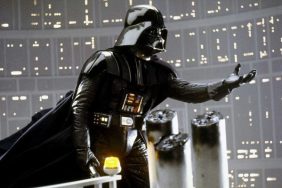Welcome to the first installment of Trolling, a new series of articles on CraveOnline, all devoted to puffing up the pop culture things you hate, and tearing down the pop culture things you love. This is a series that will, if successful, bring legitimate critical complaints about the most-lauded geek properties that world has yet seen, and offer some legitimate critical defenses to the geek properties that most often get lambasted by most audiences.
It’s designed, essentially, to outrage you. I encourage arguments, refutations, and outright hatred in the comment section below. Letsee whatchya got.
And what better place to start than 1999’s Star Wars: Episode I – The Phantom Menace, easily one of the most notorious, infamous, and picked-apart films ever made? Here, then, is why The Phantom Menace, he highest-grossing film of 1999, is a great film, and why it’s an important film that set the stage for everything you love that came after it:
George Lucas Gave You What You Wanted

The Phantom Menace was the first film made – every step of the way – with the fans in mind. When George Lucas sat down to write The Phantom Menace back in the late 1990s, his concern wasn’t what facet of the Star Wars story needs to be explored, or how his world came into being, but what the enormous Star Wars cult has been buzzing about in the 15 years since the last Star Wars movie. When we refer to “Geek Culture,” we’re usually referring to Star Wars in particular, and Lucas had all of Geek Culture in his hands at that moment.
So he sat down to write a screenplay that was, in essence, the Darth Vader story that we’ve always wanted to see. How did Darth Vader become Darth Vader? The character is more important to us, the audience, than he is to the story. The character work was trim, and the dialogue not exactly profound, and, yeah, there are a lot of plotholes and bizarre story decisions, but that we got the Darth Vader origin story at all is a miracle. This catering to the base is what has come to dictate the entire decade of superhero movies we’ve seen. If you’ve ever said something like “that was the movie I wanted,” then you owe a debt to The Phantom Menace.
The Use of Special Effects is Amazing and Changed Everything

Lucas shot The Phantom Menace with a then-unprecedented amount of digital effects. Indeed, most of the film was shot on a green-screen studio set, with the digital backgrounds to be added later. Digital effects had not been exploited like this before. Rhe late 1990s was a time of a mixing of CGI and practical effects. Thanks to Lucas’ fondness of digital toys, The Phantom Menace became the vanguard of a new SFX order, dictating that all future blockbusters can be made this way, and that fantasy films can now reach new dizzying heights of visual acuity and complexity that couldn’t be achieved practically.
Nowadays, all summer blockbusters are made in the same way, with digital backgrounds, and all-CGI finales. If you have liked any special effect since 1999, it’s because The Phantom Menace achieved such a striking and interesting look with its digital effects.
The Phantom Menace Carried Star Wars into a New Visual Idiom

And yes, you cannot deny that the film looks astonishing, providing the old Star Wars world in a new visual paradigm. In terms of aesthetics and special effects, The Phantom Menace revolutionized filmmaking. Star Wars still looks great, and little kids may still love it, but it does look, when compared to newer fantasy blockbusters, old-fashioned. This is why Lucas released the Special Editions. He tried to prove that the films could be updated. With the Special Editions, it was a bad idea. But with a new film, it carried Star Wars into the digital age. It kept the aesthetic of Star Wars present in the consciousness of kids raised on digital imagery.








